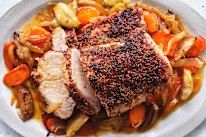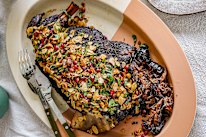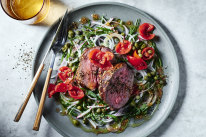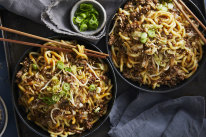RecipeTin Eats x Good Food: Best ever British roast beef (and gravy)

Updated , first published
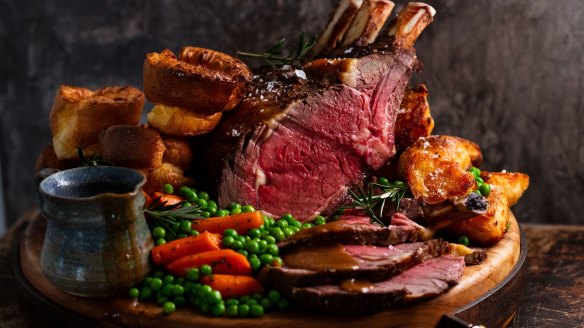
The very best roast beef is made using standing rib roast salted overnight and brought to room temperature before roasting. Please don't even think about making this without a meat thermometer. Good beef is an investment. Don't risk it!
Ingredients
2.5kg standing rib roast, 4 bones, trimmed (see note)
2½ tsp cooking salt
1 tsp black pepper
1½ tbsp beef dripping (see note) or canola oil
steamed carrots and peas to serve
Gravy (makes 750ml)
1½ litres beef stock, preferably homemade, or low-sodium store-bought
5 tbsp (50g) plain flour
½ tsp salt, or to taste
½ tsp black pepper
Method
1. The day before you intend to serve the roast, season overnight - sprinkle the beef all over with salt and refrigerate for 12-24 hours on a plate, uncovered (see note).
2. The following day, bring to room temperature - remove beef from the fridge 3 hours before cooking and bring to room temperature. Ideally, it should have Target an internal temperature in the centre of 13-15C before you start roasting, and no lower than 10C (see note).
3. Preheat oven to 220C fan-forced (240C conventional).
4. Melt and heat the dripping (or oil) in a large cast-iron frypan over high heat. Sprinkle the beef with pepper before quickly searing all over, but no longer than 45 seconds to 1 minute on each side. Remove the beef onto a plate.
5. Prepare for roasting Remove the frypan from the stove and place a small trivet or scrunched up balls of foil in pan (see note), then place the beef on top (so it's elevated off the base). If you have an oven-safe meat thermometer, insert it into the centre of the beef.
6. Roast Place the frypan in to the oven then immediately turn the temperature down to 160C fan-forced (180C conventional). Roast for about 1 hour and 20 minutes or until the internal temperature reaches 48C. If making roast potatoes, start them halfway through the beef roasting time.
7. Rest Remove the beef onto a rack set over a tray but keep the pan juices for the gravy. If it's very cold in your kitchen, loosely cover with foil. Rest for 30 minutes (up to 1 hour) – the internal temperature will rise to 56C, which is perfect medium rare.
8. Meanwhile, make the gravy. Reduce beef stock by half by simmering rapidly on medium high in a large saucepan. Set aside, keep warm.
You should have about 6 tablespoons of fat and meat juices in the frypan you used to roast the beef. If not, make up the shortfall with extra dripping or butter. If you have more, scoop off excess fat and save for Yorkshire puds.
Place the frypan on medium heat. When the dripping are is hot, add the flour and mix to form a paste. Stir for 3 minutes until it browns slightly. Switch to a whisk and while whisking slowly add half the reduced beef stock. Once the paste dissolves into the stock, add remaining stock.
Simmer for 2 to 3 minutes until it thickens to a thin gravy consistency (it will thicken as it cools between stove to table). Strain into a bowl, stir in pepper, then add more salt if desired. Pour into a gravy jug.
10. To serve, cut the meat away from the bone (it's easy) and slice the beef into 0.5 – 0.7 cm thick slices. Serve with Yorkshire puddings, roast duck fat potatoes, gravy, steamed carrots and peas (I tossed them in a little butter with finely chopped parsley).
NOTES- Standing beef rib is the Rolls-Royce of roast beef cuts. It's the juiciest and has the best flavour for a traditional blushing pink roast. Cooking it bone-in yields a juicier end result. A 2.5kg bone-in standing beef rib yields 1.6kg cooked meat after the bone is removed. Boneless scotch roast will also work. using this same recipe, use a 1.8-2kg piece will takearound 1 hour 15 minutes to roast.
- Salting the beef overnight seasons the meat inside, helps it remain juicy,intensifying the beef flavour and dries out the surface so it browns faster (which means thinner band of overcooked meat on outer rim).
- Bringing the beef to room temperature before cooking is key so you don't end up with a thick band of overcooked beef on the outside of the roast.
- Beef dripping are an essential ingredient for wickedly tasty Yorkshire puddings!) See note in that recipe.
- If you don't have a round rack or trivet, use balls of scrunched-up foil to keep your beef elevated off the base of the skillet so the base doesn't get overcooked.
- Pull the beef out of the oven when the internal temperature is no higher than 48C. It will continue cooking while standing, rising to 56C, which is perfect medium rare, when beef is at its juiciest. However, beef this good is forgiving and is still excellent up to 60C. Beyond this, you lose the pink.
Serve this roast beef recipe with RecipeTin Eats' ultimate Yorkshire pudding followed by treacle pudding. Find all the recipes for this spread in this recipe collection.
- Standing beef rib is the Rolls-Royce of roast beef cuts. It's the juiciest and has the best flavour for a traditional blushing pink roast. Cooking it bone-in yields a juicier end result. A 2.5kg bone-in standing beef rib yields 1.6kg cooked meat after the bone is removed. Boneless scotch roast will also work. using this same recipe, use a 1.8-2kg piece will takearound 1 hour 15 minutes to roast.
Appears in these collections
The best recipes from Australia's leading chefs straight to your inbox.
Sign upFrom our partners
Similar Recipes
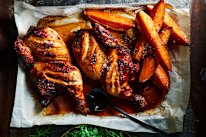
Slash and roast: The trick to cooking this spicy, sticky chicken in 30 minutes
- 30 mins - 1 hr
- Jessica Brook
More by RecipeTin Eats
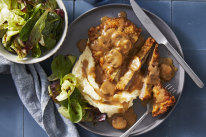
Oh crumbs! RecipeTin’s secret to making cheap but chewy minute steak a juicy, tasty joy
- 30 mins - 1 hr
- RecipeTin Eats
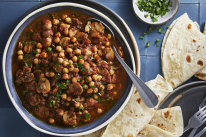
RecipeTin Eats’ one-pot spiced chickpeas and mushrooms is a vegetarian slam-dunk
- 30 mins - 1 hr
- RecipeTin Eats
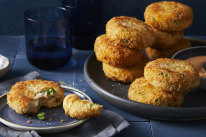
The RecipeTin magic touch that lifts these tuna patties from meh to marvellous
- 30 mins - 1 hr
- RecipeTin Eats
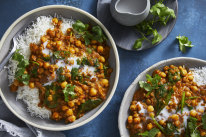
What do you call this, dhal? No, it’s RecipeTin Eats’ lentil chickpea coconut curry
- 30 mins - 1 hr
- RecipeTin Eats
Original URL: https://www.smh.com.au/link/follow-20170101-h249nb
